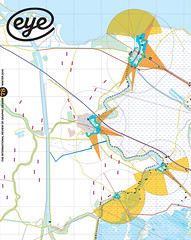Winter 2010
Mapping the city of the future
Migropolis: Venice / Atlas of a Global Situation (2 volumes)
By Wolfgang Scheppe and the IUAV Class on Politics of Representation, Hatje Cantz, €78, £60The atlas is a difficult genre to take on, given the twentieth century’s many doubts about the neutrality of information. The conventional blend of out-of-date geographical information and questionable anthropological data risks nostalgic cuteness on the one hand and outright sarcasm on the other. This scepticism extends to graphics and images as well – think of Guy Debord’s assertion that images have lost their ability to inform, doomed to reflect our ‘society of the spectacle’ affirmatively in their immediacy and sensory presence.
With these difficulties in mind, the German philosopher Wolfgang Scheppe and his students at Venice’s IUAV university set out to test the potential of information today, and the image in particular: to find out ‘whether there is visual knowledge and whether images have an explanatory potential, and if so, then how’. As Scheppe explains in the prolegomena to Migropolis, Venice would provide an ideal laboratory because it is itself an ‘urban copy’ of its own historical image.
Over the course of three years, students conducted interviews, took photographs, collected data and organised information. They took as their premise that if, despite their self-critical style, the book’s visuals ‘still fail to comprehend their subject, it means that a society grounded in visual certainty is fundamentally no longer able to achieve an understanding of itself.’
If their atlas were to succeed, information would be redeemed; images can awaken scepticism, data visualisations can enlighten, and society can change.
Over two volumes and more than 1300 pages, Migropolis offers a complex geographical portrait of present-day Venice via a dense combination of interviews, data visualisations, academic essays and images. We learn, for instance, how many people enter the city each day (175,000), in which category of news Venice appears most frequently (entertainment) and where those fake Gucci bags really come from (China, or siphoned from genuine Gucci factories in southern Italy). Over the course of the study, however, such disparate pieces of information are woven into a visual and narrative framework that leads beyond Venice to the nature of urban globalisation.
The atlas thus becomes both a political argument for the transformation of society in the face of migration, and an exploration of graphic information in the context of a global consumerist society.
In the end Migropolis’s accomplishment lies less in any particular response to criticisms of information than in the way its complex information is organised – not simply into a series of pretty graphs but a real argument. The book is ordered on the model of a Monopoly board, with themed chapters running from ‘Prospect Street’ to ‘Displacement Street’. Each chapter includes three ‘levels’ of information: data visualisations / cartographies, case studies / essays and captioned extracts from the project’s image archive. Chapter by chapter, the slippery nature of information is met with a willingness to understand, and to undertake the labour that understanding requires.
This effort is particularly evident in the way that chapters integrate photographs, graphics and text, employing whichever is appropriate to continue the argument. For instance, in the chapter on ‘Representing a Transversal City’ we learn how Claudia, a 52-year-old Moldavian cleaner working in Venice, supports her family abroad: ‘There are boys who come with a van twice a week. Through them I send money, clothes and pasta that I buy by the kilo. They’re honest. They don’t steal anything.’ The images of Claudia that accompany the interview focus on her environment: her personal affects, her papers, her walk to work. These discrete pieces of information are then placed in a broader context by visualisations of sociological data, for instance a map that depicts the web of routes between Venice and the surrounding provinces. Well captioned, colourful but not sensational, the visualisations make evident, for instance, that Claudia’s commute to work is indicative of the lack of borders between ‘Venice’ and the communities around it where the majority of the population lives.
Taken as a whole, Migropolis makes clear the degree to which Venice is a forerunner of the anonymous globalised city of the future. Finally we come to understand the connection between wealthy tourist and illegal immigrant; how the two groups sustain each other against a background of dreams and commodities. We not only read their stories, we see their relationships in the thin pink lines of money flow and travel paths that stretch over so many maps, graphs and plots.
But the last word still remains to be said. As Scheppe says, the project concluded just as the Italian government was taking an increasingly radical stance against immigration, ramping up border security and easing restrictions on deportation. Meanwhile, a weak website, some instances of over-complication and a prohibitive cost call the study’s accessibility into question. Migropolis’s real test will be whether it has the capacity to reach an ever broader public, to infiltrate the parliament and the town square, and thus to contribute to social change.
First published in Eye no. 78 vol. 20 2010
Eye is the world’s most beautiful and collectable graphic design journal, published quarterly for professional designers, students and anyone interested in critical, informed writing about graphic design and visual culture. It is available from all good design bookshops and online at the Eye shop, where you can buy subscriptions and single issues.

